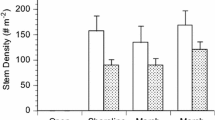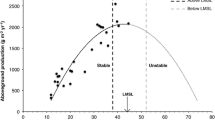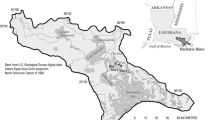Abstract
Following heavy winter storms and sedimentation in 1993,Spartina foliosa (Pacific cordgrass) clones established on a 6.5-ha mudflat in Tijuana Estuary, with over 80 new clones counted by 1997. El Niño Southern Oscillation (ENSO) storms in 1993 apparently facilitated the habitat conversion through river flooding, which caused a temporary reduction in soil salinity and delivered large volumes of sediment. Extreme sedimentation likely raised mudflat elevations enough to allowSpartina establishment. We hypothesized that clones, once established, increased sedimentation in a positive feedback loop leading to accelerated habitat conversion. We collected data on elevation,Spartina expansion, and sediment accretion in two consecutive years (1998–1999). The elevation range of the mudflats in 1998 (0.5–0.83 m NGVD) was within the elevation range ofSpartina at this site (0.39–0.83 m NGVD), indicating that remaining mudflats are at elevations suitable for further expansion. Sediment accretion ranged from 4.0–12.7 cm between 1997–1998 (ENSO conditions), but was close to long-term averages (˜ cm yr−1) in 1998–1999 (nonflood year) indicating how susceptible Tijuana Estuary is to sedimentation from episodic storms. Although accretion rates were similar withinSpartina clones and on bare mudflats over the ENSO winter, clones were typically dome-shaped suggesting higher sediment retention rates within clones. The radial expansion rates of clones (1.31±0.25 m in 1998; 1.12±0.07 m in 1999) approximated the maxima reported for this species and were not related to clone size or vigor. Conditions on the mudflat appear ideal forSpartina growth, masking differences that might otherwise be observed. Given the likelihood of sedimentation-driven habitat conversion in southern California and other Mediterranean-type estuaries, management efforts are needed to address sedimentation issues on a watershed scale. We recommend that wetland restoration projects in southern California include large areas of intertidal mudflat, both to maintain habitat for shorebird feeding and to allow colonization by salt marsh vegetation.
Similar content being viewed by others
Literature Cited
Allen, J. R. L. 1990. Salt-marsh growth and stratification: A numerical model with special reference to the Severn estuary, southwest Britain.Marine Geology 95:77–96.
Anderson, F. E., L. Black, L. E. Watling, W. Mook, andL. M. Mayer. 1981. A temporal and spatial study of mudflat erosion and deposition.Journal of Sedimentary Petrology 51:729–736.
Austen, I., T. J. Andersen, andK. Edelvang. 1999. The influence of benthic diatoms and invertebrates on the erodibility of an intertidal mudflat, the Danish Wadden Sea.Estuarine, Coastal and Shelf Science 49:99–111.
Baumann, R. H., J. W. Day, andC. A. Miller. 1984. Mississippi deltaic wetland survival: Sedimentation versus coastal submergence.Science 224:1093–1095.
Bertness, M. D. 1991. Zonation ofSpartina patens andSpartina alterniflora in a New England salt marsh.Ecology 72:138–148.
Bricker-Urso, S., S. W. Nixon, J. K. Cochran, D. J. Hirschberg, andC. Hunt. 1989. Accretion rates and sediment accumulation in Rhode Island salt marshes.Estuaries 12:300–317.
Cahoon, D. R., J. C. Lynch, andR. M. Knauss. 1996b. Improved cryogenic coring device for sampling wetland soils.Journal of Sedimentary Research 66:1025–27.
Cahoon, D. R., J. C. Lynch, andA. B. Powell. 1996a. Marsh vertical accretion in a southern California estuary, U.S.A.Estuarine, Coastal and Shelf Science 43:19–32.
Cahoon, D. R. andR. E. Turner. 1989. Accretion and canal impacts in a rapidly subsiding wetland: 2 Feldspar marker horizon technique.Estuaries 12:260–268.
Callaway, J. C. 2001. Hydrology and substrate, p. 89–117.In J. B. Zedler (ed.), Handbook for Restoring Tidal Wetlands. CRC Press, Boca Raton, Florida.
Callaway, J. C., R. D. DeLaune, andW. H. Patrick, Jr. 1997. Sediment accretion rates from four coastal wetlands along the Gulf of Mexico.Journal of Coastal Research 13:181–191.
Callaway, J. C. andM. Josselyn. 1992. The introduction and spread of smooth cordgrass (Spartina allterniflora) in south San Francisco Bay.Estuaries 15:218–226.
Callaway, J. C., J. A. Nyman, andR. D. Delaune. 1996. Sediment accretion in coastal wetlands: A review and a simulation model of processes.Current Topics in Wetland Biogeochemistry 2:2–23.
Cayan, D. R. andD. H. Peterson. 1989. The influence of North Pacific atmospheric circulation on streamflow in the west, p. 375–397.In D. H. Peterson (ed.), Aspects of Climate Variability in the Pacific and Western Americas, Geophysical Monograph 55, American Geophysical Union, Washington, D.C.
Chmura, G. L. andE. C. Kosters. 1994. Storm deposition and137Cs accumulation in fine-grained marsh sediments of the Mississippi delta plain.Estuarine, Coastal and Shelf Science 39:33–44.
Chung, C. H. 1983. Geographical distribution ofSpartina anglica C. E. Hubbard in China.Bulletin of Marine Science 33:753–758.
Clark, J. S. andW. A. Patterson III. 1985. The development of a tidal marsh: Upland and oceanic influences.Ecological Monographs 55:189–217.
Covin, J. D. andJ. B. Zedler. 1988. Nitrogen effects onSpartina foliosa andSalicornia virginica in the salt marsh at Tijuana estuary. California.Wetlands 8:51–65.
Craft, C. B., E. D. Seneca, andS. W. Broome. 1991. Loss on ignition and Kjeldahl digestion for estimating organic carbon and total nitrogen in estuarine marsh soils: Calibration with dry combustion.Estuaries 14:175–179.
Craft, C. B., E. D. Seneca, andS. W. Broome. 1993. Vertical accretion in microtidal regularly and irregularly flooded estuarine marshes.Estuarine, Coastal and Shelf Science 37:371–386.
Daehler, C. C. 1998. Variation in self-fertility and the reproductive advantage of self-fertility for an invading plant (Spartina alterniflora).Evolutionary Ecology 12:553–568.
Daehler, C. C. andD. R. Strong. 1994. Variable reproductive output among clones ofSpartina alterniflora (Poaceae) invading San Francisco Bay, California: The influence of herbivory, pollination and establishment site.American Journal of Botany 81:307–313.
Darienzo, M. E. andC. D. Peterson. 1990. Episodic tectonic subsidence of late Holocene salt marshes, northern Oregon and central Cascadia margin.Tectonics 9:1–22.
Davies, B. E. 1974. Loss-on-ignition as an estimate of soil organic matter.Soil Science Society of America Proceedings 38:150–151.
DeAngelis, D. L. andJ. C. Waterhouse. 1987. Equilibrium and nonequilibrium concepts in ecological models.Ecological Monongraphs 57:1–21.
DeLaune, R. D., R. H. Baumann, andJ. G. Gosselink. 1983. Relationships among vertical accretion, coastal submergence, and erosion in a Louisiana Gulf coast marsh.Journal of Sedimentary Petrology 53:147–157.
Desmond, J., G. Williams, M. James, J. Johnson, J. Callaway, andJ. Zedler. 1999. Tijuana River National Estuarine Research Reserve: Annual report on Ecosystem monitoring. Pacific Estuarine Research Laboratory, San Diego, California.
Entrix, Inc., Pacific Estuarine Research Laboratory, and Philip Williams and Associates. 1991. Tijuana Estuary tidal restoration program: Draft environmental impact report/environmental impact statement. Volume I–III. California Coastal Conservancy (SCC) and U.S. Fish and Wildlife Service. SCC, Oakland, California.
Feist, B. E. andC. A. Simenstad. 2000. Expansion rates and recruitment frequency of exotic smooth cordgrass,Spartina alterniflora (Loisel), colonizing unvegetated littoral flats in Willapa Bay, Washington.Estuaries 23:267–274.
Flick, R. E. andD. R. Cayan. 1984. Extreme sea levels on the coast of California, p. 886–898.In B. L. Edge, (ed.), Nineteenth Coastal Engineering Conference, Houston, Texas, American Society of Civil Engineers, New York.
French, J. R. 1993. Numerical simulation of vertical marsh growth and adjustment to accelerated sea-level rise, North Norfolk, U.K..Earth Surface Processes and Landforms 18:63–81.
Frostick, L. E. andI. N. McCave. 1979. Seasonal shifts of sediment within an estuary mediated by algal growth.Estuarine and Coastal Marine Science 9:569–576.
Gee, B. W. andJ. W. Bauder. 1986. Particle size analysis, p. 399–409.In A. Klute (ed.), Methods of Soil Analysis. Part I: Physical and Mineralogical Methods, 2nd edition. American Society of Agronomy and the Soil Science Society of America, Madison, Wisconsin.
Gleason, M. L., D. A. Elmer, N. C. Pien, andJ. S. Fisher. 1979. Effects of stem density upon sediment retention by salt marsh cord grass (Spartina alterniflora Loisel).Estuaries 2:271–273.
Goodbred, Jr.,S. L. andA. C. Hine. 1995. Coastal storm deposition: Salt-marsh response to a severe extratropical storm, March 1993, west-central Florida.Geology 23:679–982.
Gornitz, V. 1995. Monitoring sea level changes.Climatic Change 31:515–544.
Haltiner, J. P. andM. Swanson. 1987. Geomorphology and hydrology of the Tijuana River, Technical appendix A-2.In P. B. Williams and M. L. Swanson (eds.), Tijuana Estuary Enhancement Hydrologic Analysis, Philip Williams and Associates, San Francisco, California.
Hatton, R. S., R. D. DeLaune, andW. H. Patrick, Jr. 1983. Sedimentation, accretion, and subsidence in marshes of Barataria Basin, Louisiana.Limnology and Oceanography 28:494–502.
Hensel, P. F., J. W. Day, Jr., andP. Didier. 1999. Wetland vertical accretion and soil elevation change in the Rhône River Delta, France: The importance of riverine flooding.Journal of Coastal Research 15:668–681.
Hubbard, J. C. E. 1965.Spartina marshes in southern England VI. Pattern of invasion in Poole Harbor.Journal of Ecology 53:799–813.
Kern, J. P. 1977. Origin and history of upper Pleistocene marine terraces, San Diego, California.Geological Society of America Bulletin 88:1553–1566.
Kus, B. E. andP. Ashfield. 1989. Bird use of the Tijuana River estuary. Final Report. California Department of Fish and Game, Sacramento, California.
Kwak, T. J. andJ. B. Zedler. 1997. Food web analysis of southern California coastal wetlands using multiple stable isotopes.Oecologia 110:262–277.
Lant, C. L. 1999. Human dimensions of watershed management: Introduction.Journal of the American Water Resources Association 35:483–486.
Leonard, L. A., A. C. Hine, M. E. Luther, R. P. Stumpf, andE. E. Wright. 1995. Sediment transport processes in a west-cen tral Florida open marine marsh tidal creek; the role of tides and extra-tropical storms.Estuarine, Coastal and Shelf Science 41: 225–248.
Letzch, W. S. andR. W. Frey. 1980. Deposition and erosion in a Holocene salt marsh, Sapelo Island, Georgia.Journal of Sedimentary Petrology 50:529–542.
Levin, L. A., T. Talley, A. Larson, andA. Jones. 1997. Faunal Composition in the Tijuana River Estuarine Intertidal Habitats and the Role of Life Histories in Faunal Recovery of Southern California Restored Wetlands. Scripps Institution of Oceanography. La Jolla, California.
Lindig-Cisneros, R. J. Desmond, K. Boyer, and J. B. Zedler. In press. Wetland restoration thresholds: Can a degradation transition be reversed with increased effort?Ecological Applications.
Macdonald, K. B., R. F. Ford, E. B. Cooper, P. Unitt, andJ. P. Haltiner. 1990. South San Diego Bay Enhancement Plan: Volume 2/Resource Atlas. San Diego Unified Port District and California State Coastal Conservancy, Michael Brandman Associates, Inc. San Diego, California.
Michaelsen, J. 1989. Long-period fluctuations in El Niño, amplitude and frequency reconstructed from tree-rings, p. 69–74.In D. H. Peterson (ed.), Aspects of Climate Variability in the Pacific and Western Americas Geophysical Monograph 55. American Geophysical Union, Washington, D.C..
Mook, D. H. andC. M. Hoskin. 1982. Organic determinations by ignition: Caution advised.Estuarine, Coastal and Shelf Science 15:697–99.
Morris, J. T. andB. Haskin. 1990. A 5-yr record of aerial primary production and stand characteristics ofSpartina alterniflora.Ecology 71:2209–2217.
Mudie, P. J. andR. Byrne. 1980. Pollen evidence for historic sedimentation rates in California coastal marshes.Estuarine and Coastal Marine Science 10:305–16.
Naiman, R. J., P. A. Bisson, R. G. Lee, andM. G. Turner. 1997. Approaches to management at the watershed scale, p. 239–253.In K. A. Kohm and J. F. Franklin (eds.) Creating a Forestry for the 21st Century: The Science of Ecosystem Management. Island Press, Washington, D.C..
Nowell, A. R. M., P. A. Jumars, andJ. E. Eckman. 1981. Effects of biological activity on the entrainment of marine sediments.Marine Geology 42:133–53.
Nuttle, W. K., M. M. Brinson, D. Cahoon, J. C. Callaway, R. R. Christian, G. L. Chmura, W. H. Conner, R. H. Day, M. Ford, J. Grace, J. C. Lynch, R. A. Orson, R. W. Parkinson, D. Reed, J. M. Rybczyk, T. J. Smith, III,R. P. Stumpf, andK. Williams. 1997. Conserving coastal wetlands despite sea level rise.EOS 78:258, 260–261.
Nyman, J. A., C. R. Crozier, andR. D. DeLaune. 1995. Roles and patterns of hurricane sedimentation in an estuarine marsh landscape.Estuarine, Coastal and Shelf Science 40:665–679.
Nyman, J. A., R. D. DeLaune, andW. H. Patrick, Jr. 1990. Wetland soil formation in the rapidly subsiding Mississippi River Deltaic Plain: Mineral and organic matter relationships.Estuarine, Coastal and Shelf Science 31:57–69.
Orson, R. A. andB. L. Howes. 1992. Salt marsh development studies at Waquoit Bay, Massachusetts: Influence of geomorphology on long-term plant community structure.Estuarine, Coastal and Shelf Science 35:453–471.
Orson, R. A., R. L. Simpson, andR. E. Good. 1990. Rates of sediment accumulation in a tidal freshwater marsh.Journal of Sedimentary Petrology 60:859–869.
Orson, R. A., R. S. Warren, andW. A. Niering. 1987. Development of a tidal marsh in a New England river valley.Estuaries 10:20–27.
Orson, R. A., R. S. Warren, andW. A. Niering. 1998. Interpreting sea level rise and rates of vertical marsh accretion in a southern New England tidal salt marsh.Estuarine, Coastal and Shelf Science 47:419–429.
Parker-Chapman, D. L. 1995. Shorebird foraging and aggression in relation to population size and species composition. M.S. Thesis, San Diego State University. San Diego, California.
Pasternack, G. B andG. S. Brush. 1998. Sedimentation cycles in a river-mouth tidal freshwater marsh.Estuaries 21:407–415.
Patrick, Jr.,W. H. andR. D. DeLaune. 1990. Subsidence, accretion, and sea level rise in south San Francisco Bay marshes.Limnology and Oceanography 35:1389–1395.
Pestrong, R. 1972. Tidal-flat sedimentation at Cooley Landing, southwest San Francisco.Sedimentary Geology 8:251–288.
Pethick, J. S. 1981. Long-term accretion rates on tidal salt marshes.Journal of Sedimentary Petrology 51:571–577.
Phleger, C. F. 1971. Effect of salinity on growth of a salt marsh grass.Ecology 52:908–911.
Pickett, S. T. A. 1980. Non-equilibrium coexistence of plants.Bulletin of the Torrey Botanical Society 107:238–248.
Purer, E. A. 1942. Plant ecology of the coastal salt marshlands of San Diego County, California.Ecological Monographs 12:82–111.
Ranwell, D. S. 1964a.Spartina salt marshes in southern England: II. Rate and seasonal pattern of sediment accretion.Journal of Ecology 52:79–94.
Ranwell, D. S. 1964b.Spartina salt marshes in southern England: III. Rates of establishment, succession and nutrient supply at Bridgwater Bay, Somerset.Journal of Ecology 52:95–106.
Redfield, A. C. 1972. Development of a New England salt marsh.Ecological Monographs 42:201–237.
Reed, D. J. 1990. The impact of sea-level rise on coastal salt marshes.Progress in Physical Geography 14:465–481.
Roman, C. T., J. A. Peck, J. R. Allen, J. W. King, andP. G. Appleby. 1997. Accretion of a New England (USA) salt marsh in response to inlet migration, storms, and sea-level riseEstuarine, Coastal and Shelf Science 45:717–727.
Rybczyk, J. M., J. C. Callaway, andJ. W. Day, Jr. 1998. A relative elevation model for a subsiding coastal forested wetland receiving wastewater effluent.Ecological Modelling 112:23–44.
Schonher, T. andS. E. Nicholson. 1989. The relationship between California rainfall and ENSO events.Journal of Climate 2:1258–1269.
Shumway, S. W. 1995. Physiological integration among clonal ramets during invasion of disturbance patches in a New England salt marsh.Annals of Botany 76:225–233.
Simenstad, C. A. andR. M. Thom. 1995.Spartina alterniflora (Smooth cordgrass) as an invasive halophyte in Pacific Northwest estuaries.Hortus Northwest 6:9–12, 38–40.
Sokkia Corporation 1997. GSR2300 GPS System Specifications. Sokkia Corporation. Overland Park, Kansas.
Stevenson, J. C., L. G. Ward, andM. S. Kearney. 1986. Vertical accretion in marshes with varying rates of sea level rise, p. 241–259.In D. A. Wolfe (ed.), Estuarine Variability. Academic Press, Orlando, Florida.
Stoddart, D. R., D. J. Reed, andJ. R. French. 1989. Understanding salt marsh accretion. Scolt Head Island, Norfolk, England.Estuaries 12:228–236.
Stumpf, R. P. 1983. The process of sedimentation on the surface of a salt marsh.Estuarine, Coastal and Shelf Science 17:495–508.
Tate, III,R. L 1987. Soil Organic Matter: Biological and Ecological Effects. John Wiley & Sons, New York.
Teal, J. M. andB. L. Howes. 1996. Interannual, variability of a salt-marsh ecosystem.Limnology and Oceanography 41:802–809.
Thom, R. M. 1992. Accretion rates of low intertidal salt marshes in the Pacific Northwest.Wetlands 12:147–156.
Trnka, S. J. andJ. B. Zedler. 2000. Site, conditions, not parental phenotype, determine the height ofSpartina foliosa.Estuaries 23:572–582.
Turner, R. E., E. M. Swenson andC. S. Milan. 2001. Organic and inorganic contributions to vertical accretion, in salt marsh sediments, p. 583–595.In M. Weinstein and K. Kreeger (eds.), Concepts and Controversies in Tidal Marsh Ecology. Kluwer Academic, Dodrecht, Netherlands.
Vince, S. W. andA. A. Snow. 1984. Plant zonation in an Alaskan salt marsh: I. Distribution, abundance and environmental factors.Journal of Ecology 72:651–657.
Ward, K. M. 2000. Episodic colonization of an intertidal mudflat by cordgrass (Spartina foliosa) at Tijuana estuary. M.S. Thesis, San Diego State University, San Diego, California.
Warren, R. S. andW. A. Niering. 1993. Vegetation change on a northeast tidal marsh: Interaction of sea-level rise and marsh accretion.Ecology 74:96–103.
Weis, D. A., J. C. Callaway, andR. M. Gersberg. 2001. Vertical accretion rates and heavy metal chronologies in wetland sediments of the Tijuana estuary.Estuaries 24:840–850.
West, J. M., M. E. Cordrey, K. M. Ward, andJ. B.Zedler. 2001. Tijuana River National Estuarine Research Reserve: Annual report on ecosystem monitoring. Pacific Estuarine Research Laboratory, San Diego, California.
Williams J. E., C. A. Wood, andM. P. Dombeck. 1997. Watershed Restoration: Principles and Practices. American Fisheries Society, Bethesda, Maryland.
Wu, J. andO. L. Loucks. 1995. From balance of nature to hierarchical patch dynamics: A paradigm shift in ecology.The Quarterly Review of Biology 70:439–466.
Zedler, J. B. 1977. Salt marsh community structure in the Tijuana estuary, California.Estuarine and Coastal Marine Science 5:39–53.
Zedler, J. B. 1983. Freshwater impacts in normally hypersaline marshes.Estuaries 6:346–355.
Zedler, J. B. 1984. Salt marsh restoration: A guidebook for southern California. Report Number TCSGCP-009. California Sea Grant College Program, University of California, La Jolla, California.
Zedler, J. B. 1986. Catastrophic flooding and distributional patterns of Pacific cordgrass (Spartina foliosa Trin.).Bulletin of the Southern California Academy of Sciences 85:74–76.
Zedler J. B. 1993. Canopy architecture of natural and planted cordgrass marshes: Selecting habitat evaluation criteria.Ecological Applications 3:123–138.
Zedler, J. B., J. C. Callaway, J. S. Desmond, G. Vivian-Smith, G. D. Williams, G. Sullivan, A. E. Brewster, andB. K. Bradshaw. 1999. Californian salt-marsh vegetation: An improved model of spatial pattern.Ecosystems 2:19–35.
Zedler, J. B., C. S. Nordby, andB. E. Kus. 1992. The Ecology of Tijuana Estuary: A National Estuarine Research Reserve. National Oceanic and Atmospheric Administration, Office of Coastal Resource Management, Sanctuaries and Reserve Division, Washington, D.C..
Zembal, R., B. W. Massey, andJ. M. Fancher. 1989. Movements and activities of the light-footed clapper rail.Journal of Wildlife Management 53:39–42.
Sources of Unpublished Materials
International Boundary and Waters Commission. Unpublished data. U.S. Section, San Diego Office, 2225 Dairy Mart Road, San Ysidro, California 92173. http://www.ibwc.state.gov.
National Weather Service. Unpublished data. 11440 West Bernardo Court, Suite 230, San Diego, California 92127. http://www.wrh.noaa.gov/sandiego/climate.html.
Perl (Pacific Estuarine Research Laboratory). Unpublished data. San Diego State University, San Diego, California 92182-1870.
U.S. Geological Service. Unpublished data. California District Office. Sacramento, California 95819. http://waterdata.usgs.gov.
Author information
Authors and Affiliations
Corresponding author
Rights and permissions
About this article
Cite this article
Ward, K.M., Callaway, J.C. & Zedler, J.B. Episodic colonization of an intertidal mudflat by native cordgrass (Spartina foliosa) at Tijuana Estuary. Estuaries 26, 116–130 (2003). https://doi.org/10.1007/BF02691699
Received:
Revised:
Accepted:
Issue Date:
DOI: https://doi.org/10.1007/BF02691699




